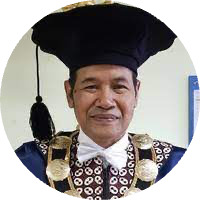The Imaginary Line Across Yogyakarta Land as an Ethnomathemathics Study
DOI:
https://doi.org/10.21831/ej.v4i1.59984Keywords:
Yogyakarta imaginary line, Tugu Pal Putih, Yogyakarta Palace, Mount Merapi, Parangkusumo Beach.Abstract
In attempt to explore Yogyakarta, the heritage city of Indonesia, the well known landmark, Tugu Pal Putih and the Yogyakarta Imaginary Line is explored. The purpose of this paper is to describe that this cultural context may be used as a reference for geometry learning. The method used in this research is a descriptive qualitative involving two historian experts in interviews. The results are that this line can be explored through ethnomathematics studies based on points, straight lines, comparison of distances between points on the imaginary line and the extension of the imaginary line. This line can be illustrated by an imaginary point located at the Tugu Pal Putih as the starting point to focus on thinking of the mathematical object. This line not only divides Yogyakarta imaginatively but also according to natural boundaries such as rivers. The extension of the imaginary line forms an area called the fertility area. The description of the patterns formed on the Yogyakarta Imaginary Line through ethnomathematics is expected to be used further as materials in the mathematics learning process.
References
Ashari, D.R. (2022). Kesan Pertama Citra Kawasan Berdasarkan Peta Mental Wisatawan (Studi Kasus di Ruas Tugu Jogja – Titik Nol km di Kawasan Malioboro). Tesis. Universitas Islam Indonesia. Yogyakarta. https://dspace.uii.ac.id/handle/123456789/40960
Cahya, G. A., Mahendra, Y. K. D. & Damanik, I. I. (2017). Malioboro as a value of special district of Yogyakarta city. Iop Conference Series: Earth and Environmental Science. https://iopscience.iop.org/article/10.1088/1755-1315/70/1/012055/meta
Cimen, O. A. (2014). Discussing ethnomathematics: Is mathematics culturally dependent?. Procedia-Social and Behavioral Sciences, 152, 523-528. https://doi.org/10.1016/j.sbspro.2014.09.215
D'Ambrosio, U. (2012). The program ethnomathematics: Theoretical basis and the dynamics of cultural encounters. Cosmopolis, 3(4), 13–41.
Deda, Y. N., & Amsikan, S. (2019). Geometry Concept on the Motifs of Woven Fabric in Kefamenanu Community. JRAMathEdu (Journal of Research and Advances in Mathematics Education), 4 (1), 23-30. https://doi.org/10.23917/jramathedu.v4i1.6253
Ditasona, C. (2018). Ethnomathematics exploration of the Toba community: Elements of Geometry transformation contained in Gorga (Ornament on Bataks House). IOP Conference Series: Material Science and Engineering, 335 012042. http://dx.doi.org/10.1088/1757-899X/335/1/012042
DIY Cultural Office. (2016). Mayangkara Sumbu Filosofis Yogyakarta. Dinas Kebudayaan DIY
Hoogland, K., Pepin, B., Koning, J. d., Bakker, A. & Gravemeijer, K. (2018) Word problems versus image-rich problems: an analysis of effects of task characteristics on students' performance on contextual mathematics problems. Research in Mathematics Education, 20(1), 37-52, https://doi.org/10.1080/14794802.2017.1413414
Isroi, A., Suripah, S., & Rezeki, S. (2022). Kambuik Kuantan Singingi culture for realistic mathematics education approach. Ethnomathematics Journal, 3(1), 1-10. http://dx.doi.org/10.21831/ej.v3i1.44988
Jovenski, T.W. (2022). Masterplan Multi Hub Public Place Gowongan Dengan Pendekatan Place Theory Di Kota Yogyakarta. Skripsi. Universitas Atma Jaya Yogyakarta. http://e-journal.uajy.ac.id/28055/
Jurgensen, R. C.; Donnelly, A. J.; and Dolciani, M. P. Modern Geometry: Structure and Method. Boston, MA: Houghton-Mifflin, p. 22, 1963.
Lambert VA, & Lambert CE. Qualitative Descriptive Research: An Acceptable Design. PRIJNR [Internet]. 2013 Jan. 31 [cited 2023 Feb. 9];16(4):255-6. Available from: https://he02.tci-thaijo.org/index.php/PRIJNR/article/view/5805
Mauluah, L. (2022). Studying mathematics around Keraton Yogyakarta. Ethnomathematics Journal, 3(1), 11-18. https://doi.org/10.21831/ej.v3i1.40000 .
Meliana, S. & Carolie, O. S. (2020). A review of the role of intangible axis toward the Pathok Negoro's design concept Yogyakarta. Humaniora, 11(3), 169-175. https://doi.org/10.21512/humaniora.v11i3.6540
Pathuddin, H., Kamariah, & Nawawi, M.I. (2021). Buginese Ethnomathematics: Barongko Cake Explorations as Mathematics Learning Resources. Journal on Mathematics Education,12(2), 295-312. http://doi.org/10.22342/jme.12.2.12695.295-312
Pereira, J., Wijaya, T. T. Zhou, Y. & Purnama, A. (2021). Learning points, lines, and plane Geometry with Hawgent dynamics mathematics software. 1882 (1). http://dx.doi.org/10.1088/1742-6596/1882/1/012057
Prahmana, R.C.I.,Yunianto, W., Rosa, M., & Orey, D.C. (2021). Ethnomathematics: Pranatamangsa System and the Birth-Death Ceremonial in Yogyakarta. Journal on Mathematics Education, 12(1), 93-112. https://doi.org/10.22342/jme.12.1.11745.93-112
Prahmana, R. C. I & D'Ambrosio, U. (2020). Learning Geometry and values from patterns: Ethnomathematics on the batik patterns og Yogyakarta, Indonesia. Journal on Mathematics Education, 11(3), 439-456. https://doi.org/10.22342/jme.11.3.12949.439-456
Pramudita, K. & Rosnawati, R. (2019). Exploration of Javanese culture ethnomathematics based on Geometry perspective. Journal of Physics: Conference Series, 1200 012002. http://dx.doi.org/10.1088/1742-6596/1200/1/012002
Rochsun, R. & Agustin, R. D. (2020). The development of E-Module mathematics based on contextual problems. European Journal of Educational Studies, 7 (10), 400-412. http://dx.doi.org/10.46827/ejes.v7i10.3317
Salavera, C., Usán, P., & Teruel, P. (2019). Contextual problems, emotional intelligence and social skills in Secondary Education students. Gender differences. Annales Médico-Psychologiques, Revue Psychiatrique, 177(3), 223–230. https://doi.org/https://doi.org/10.1016/j.amp.2018.07.008
Setyowati, E., Hardiman, G., & Murtini, T. W. (2018). Pathok Negoro mosque as the form of territorial defense region of Mataram Kingdom of Islam in Jogjakarta. IOP Conference Series: Earth and Environmental Science, 106, 1-6. https://doi.org/10.1088/1755-1315/106/1/012074
Supriadi, Suryadi, D., Sumarmo, U, & Rakhmat, C. (2014). Developing Mathematical Modeling Ability Students Elementary School Teacher Education through Ethnomathematics-based Contextual Learning. International Journal of Education and Research. 2(8): 439-452. https://www.ijern.com/journal/2014/August-2014/40.pdf
Suryanto DA, Sudaryono. (2015). Aspek budaya dalam keistimewaan tata ruang kota Yogyakarta. [Cultural aspect in the speciality of Yogyakarta urban spatial planning]. Jurnal Perencanaan Wilayah dan Kota. 26(3):230–52. https://doi.org/10.5614%2Fjpwk.2015.26.3.6.
Syamsuddin, M., Jannah, K., Indriani, N., Fathin, M.I., Sunandar, A.P., Setiawan, B. 2021. Sinar Rembulan Menerangi Kebudayaan: Studi Hubungan Muhammadiyah dan Islam Jawa. Yogyakarta: UNY Press.
Utami, N. W., Sayuti, S. A., Jailani, J. (2019). Math dan mate in javanese primbon: Ethnomathematics study. Journal on Mathematics Education, 10(3), 341-356. https://doi.org/10.22342/jme.10.3.7611.341-356
Webb, J. H. (1974). A Straight Line Is the Shortest Distance between Two Points. The Mathematical Gazette, 58(404), 137. https://doi.org/10.2307/3617801
Downloads
Published
How to Cite
Issue
Section
Citation Check
License
The authors submitting a manuscript to this journal agree that, if accepted for publication, copyright publishing of the submission shall be assigned to Ethnomathematics Journal. However, even though the journal asks for a copyright transfer, the authors retain (or are granted back) significant scholarly rights.

Ethnomathematics Journal by https://journal.uny.ac.id/index.php/ethnomath is licensed under a Creative Commons Attribution-ShareAlike 4.0 International License.












